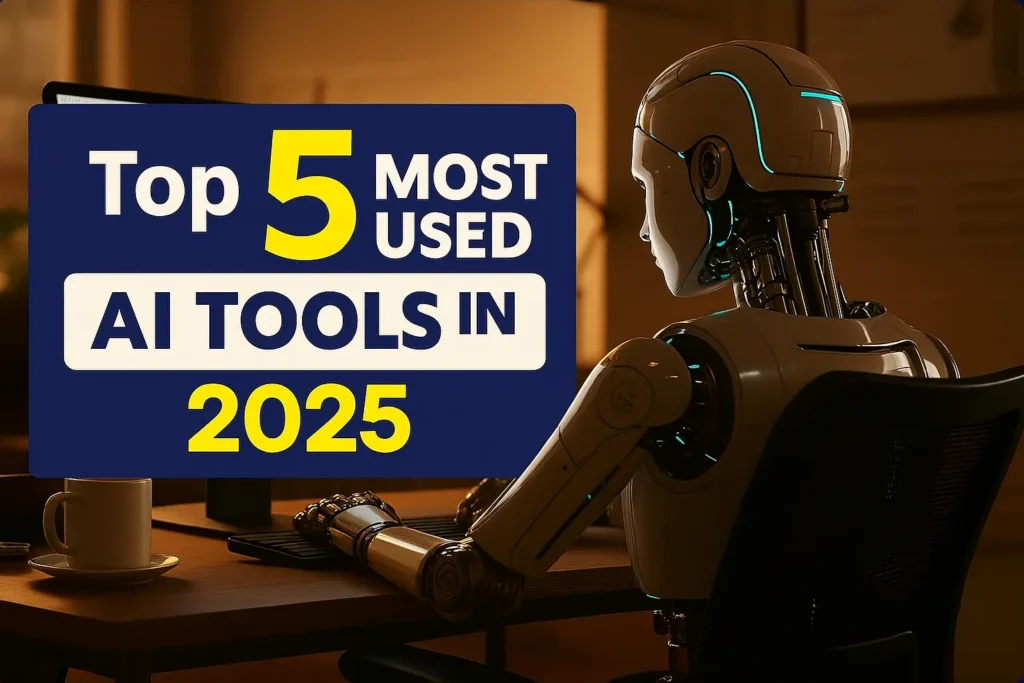From virtual collaborators to creative co-pilots, the 5 Most Used AI Tools in 2025 are reshaping how we work, think, and create—faster, smarter, and more human than ever.
Introduction: The 5 Most Used AI Tools in 2025 Are Changing Everything About Work

In 2025, artificial intelligence isn’t just helping us—it’s working with us.
From classrooms to boardrooms, the 5 most used AI tools in 2025 are redefining how we write, design, analyze, and communicate. What used to take hours of manual effort can now be done in minutes, thanks to powerful tools like ChatGPT, Microsoft Copilot, Canva AI, Midjourney, and Grammarly.
But these tools aren’t just trendy add-ons. They’re part of a larger shift: a new era where AI enhances human potential instead of replacing it. Whether you’re a student writing a thesis, a designer crafting visuals, or a business leader preparing reports, these AI tools are becoming your silent partners—boosting productivity, unlocking creativity, and transforming how work gets done.
So what makes these tools stand out from thousands of others in the AI space? Let’s dive into how the most popular AI tools of 2025 earned their place—and what they can do for you.
1. ChatGPT (OpenAI) – The Ubiquitous AI Assistant of the 2020s
- Users: ~180 million active users
- User Rating: ⭐ 4.6/5
- Launched: 2022
- Country: USA
- Key Uses: Writing assistance, brainstorming, education, coding help, customer support
Imagine having a personal assistant who knows everything on the internet, never sleeps, and can help you write a report, debug a line of code, or even brainstorm a marketing pitch—all in seconds.
That’s the reality for millions of users who rely on ChatGPT, the flagship AI product from OpenAI. Launched in late 2022, ChatGPT quickly surpassed expectations. By mid-2025, it had reached over 180 million users—making it the most widely adopted AI tool globally.
Its success comes from more than just powerful language generation. OpenAI continuously expanded its capabilities, integrating tools like web browsing, code interpreters, memory for personalized responses, and access to third-party plugins. Whether you’re a student, business analyst, HR manager, or stay-at-home parent—ChatGPT offers utility across every role.
More importantly, its conversational interface makes interacting with technology feel less robotic and more human.
2. Microsoft Copilot – AI That Lives Inside Your Workday
- Users: ~100 million (within Microsoft Office ecosystem)
- User Rating: ⭐ 4.5/5
- Launched: 2023
- Country: USA
- Key Uses: Automating tasks in Word, Excel, Outlook; productivity analytics
When Microsoft announced Copilot in early 2023, it wasn’t just launching a new feature—it was changing how over a billion Office users would work. Copilot was not a separate app but a seamless integration directly into Word, Excel, Outlook, Teams, and PowerPoint.
Now, users can ask Excel to generate a forecast model, have Word draft an entire report based on bullet points, or let Outlook summarize a week’s worth of emails and schedule replies—all through natural language prompts.
Behind the scenes, Copilot is powered by OpenAI’s large language models, but Microsoft added layers of enterprise-grade security and context-awareness to ensure data privacy. For businesses and organizations already entrenched in the Microsoft ecosystem, adoption was frictionless.
By mid-2025, Copilot is used by more than 100 million professionals and has become an invisible partner in decision-making, reporting, and communication.
3. Canva AI – Democratizing Design with Intelligence
- Users: ~65 million active users
- User Rating: ⭐ 4.7/5
- Launched: 2013 (AI added in 2022)
- Country: Australia
- Key Uses: Graphic design, social media visuals, presentations, content creation
Canva was already a powerhouse in the design world before AI. But once it added Magic Write, Magic Edit, and Magic Design in 2022, it became unstoppable.
Suddenly, marketers didn’t need to rely on full-time designers to create ad creatives. Small business owners could generate entire presentations with design consistency in minutes. Social media managers could auto-generate posts tailored for Instagram, LinkedIn, or TikTok—complete with AI-generated captions and layouts.
Its AI tools are easy to use, even for people with zero design background. Canva AI can remove backgrounds, upscale images, generate copy, suggest layouts, and more—all while keeping brand identity intact. It’s this blend of accessibility and power that has earned Canva over 65 million active users in 2025.
The platform has even expanded into video editing and document creation, aiming to become the “AI Office Suite” for creatives.
4. Midjourney – Visual Imagination, Made Real
- Users: ~20 million
- User Rating: ⭐ 4.8/5
- Launched: 2022
- Country: USA
- Key Uses: AI art generation, concept design, visual storytelling
If there’s one AI tool that’s made artists fall in love with machines, it’s Midjourney.
Running entirely through a Discord server, Midjourney allows users to type prompts like “a futuristic cityscape at sunset, cyberpunk style” and receive jaw-dropping visuals in under a minute. These are not generic images—they’re works of art, often with signature stylistic details.
Unlike DALL·E or Firefly, Midjourney cultivated a strong visual aesthetic that resonated with game designers, illustrators, content creators, and even fashion designers. In 2025, it’s used in storyboarding, comic creation, marketing, and NFT design.
Its growth isn’t just about beautiful images. It tapped into a creative economy craving rapid prototyping, mood boards, and visual storytelling—without needing hours of manual design.
5. Grammarly – The AI That Polishes Every Word You Write
- Users: ~30 million daily users
- User Rating: ⭐ 4.5/5
- Launched: 2009 (AI expansion from 2018 onward)
- Country: USA
- Key Uses: Grammar correction, tone detection, clarity improvement, professional writing
Before ChatGPT made generative AI mainstream, Grammarly was already helping people write better. But the version of Grammarly in 2025 is a far cry from its humble beginnings.
With its AI-driven tone analysis, rewrite suggestions, context-aware grammar correction, and integrations across platforms like Gmail, Notion, Google Docs, and Slack—Grammarly has evolved into a full-fledged communication coach.
It now even offers goal-based writing modes (e.g., persuasive, instructional, narrative), and can flag sensitive or biased language in professional writing. For many professionals, it’s the last pair of eyes before sending an email, publishing a report, or submitting a proposal.
Its ability to operate in real time and across multiple devices makes it a favorite among executives, students, and anyone who wants to write with clarity and confidence.
The Future Isn’t Just AI—It’s Collaborative Intelligence
What these five tools show us is that the future of AI is not about replacing humans—it’s about augmenting our strengths. Each tool represents a new kind of partnership between human intuition and machine intelligence:
- ChatGPT helps us think clearer and faster.
- Microsoft Copilot gets us through the grind of daily reports and analysis.
- Canva AI turns raw ideas into polished visuals.
- Midjourney gives our imagination a canvas.
- Grammarly ensures our words are as sharp as our ideas.
In a world where speed, clarity, and creativity are the currency of success, these tools are no longer optional—they’re foundational.
🔎 Quick Comparison Table (2025)
| Tool | Users | Best For | Country | User Rating |
|---|---|---|---|---|
| ChatGPT | 180M | Writing, brainstorming, education | USA | ⭐ 4.6/5 |
| Copilot | 100M | Office productivity & automation | USA | ⭐ 4.5/5 |
| Canva AI | 65M | Design, content creation | Australia | ⭐ 4.7/5 |
| Midjourney | 20M | AI art, storytelling | USA | ⭐ 4.8/5 |
| Grammarly | 30M daily | Writing clarity, tone checking | USA | ⭐ 4.5/5 |
Conclusion: Why the 5 Most Used AI Tools in 2025 Matter More Than Ever
The future of work isn’t coming—it’s already here. And at the heart of this transformation are the 5 most used AI tools in 2025 that millions rely on every single day.
These tools—ChatGPT, Microsoft Copilot, Canva AI, Midjourney, and Grammarly—aren’t just software. They’re extensions of how we think, work, write, and create. Whether you’re building a brand, managing data, designing content, or simply trying to communicate more clearly, these AI tools offer the edge you need to stay ahead.
But this is only the beginning.
The next wave of AI won’t just assist—it will anticipate. From real-time personalization to cross-platform collaboration, we are entering an era where humans and AI work in seamless harmony.
As you explore these tools, remember: the true power of AI lies not in replacing you—but in amplifying your ideas.
🔍 Cited Sources
- Official usage and rating stats compiled from TechCrunch, The Verge, Bloomberg, and company press releases.
- Updated user data and release notes retrieved in 2025 from official product updates on OpenAI, Microsoft, Canva, Midjourney, and Grammarly platforms.
📚 Further Reading
If you’re interested in how AI is changing every part of digital productivity, check out these in-depth guides:
